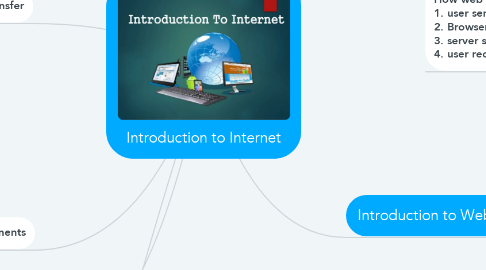
1. Introduction to World Wide Web
1.1. World Wide Web is information space and can be accessed via the internet.
1.2. Web Advantages
1.2.1. Creates a virtual hyperspace example bring the whole world together.
1.2.2. A low cost way to share, maintain and distribute information example Electronic commerce.
1.3. Network Basic
1.3.1. HTML - content-based the codes describe what the contents of the document are.
1.3.2. Domain Name System (DNS) - symbolic name for IP address example portal.uum.edu.my
1.3.2.1. URL (Uniform resource locator) internet address consist of protocol, host name and path.
2. Data Transfer
2.1. Packet Switching
2.2. Circuit Switching (telephone network)
3. Network Components
3.1. hosts
3.1.1. routers
3.1.1.1. links of various media
3.1.1.2. applications
3.1.1.2.1. protocols
4. Layer of Internet
4.1. Network layer (connect local network)
4.1.1. Transport layer (manages flow data)
4.1.1.1. Application layer example : HTTP, FTP,SMTP,DNS
4.2. Data link layer (manages transmission data within network).
5. Introduction to Web Application
5.1. Web Application Architecture
5.1.1. Web Browser
5.1.1.1. Web Server
5.1.1.1.1. Database Server
6. How web works 1. user send request 2. Browser interprets user selection and moves appropriate server 3. server send request files to browser to be interpreted. 4. user receives file displayed by the browser
6.1. Software for the component of web application
6.1.1. a client-server application program or interactive web site which stored and run on a web server to delivered over the internet through a browser. Example : UUM portal.
6.1.1.1. Server Side 1. Written for the purpose to execute a special task. 2. Executed on the server to generate responses for clients.
6.1.1.2. Client Side 1. Programs that are executed at client side/ web browser. 2. Can be prepared and implemented offline.
